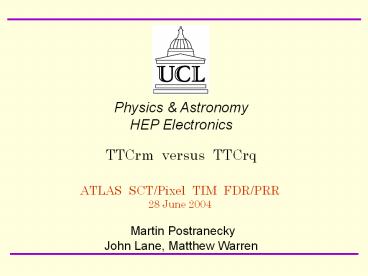TTCrm%20versus%20TTCrq - PowerPoint PPT Presentation
Title:
TTCrm%20versus%20TTCrq
Description:
Originally selected as the TTCrx mezzanine board to be used on TIM-3 ... A new mezzanine card is being designed as an alternative to the existing TTCrm ... – PowerPoint PPT presentation
Number of Views:59
Avg rating:3.0/5.0
Title: TTCrm%20versus%20TTCrq
1
Physics AstronomyHEP Electronics
TTCrm versus TTCrq
ATLAS SCT/Pixel TIM FDR/PRR 28 June 2004
Martin PostraneckyJohn Lane, Matthew Warren
2
TTCrm
- Originally selected as the TTCrx mezzanine board
to be used on TIM-3 - Uses 2 connectors J1 and J2
- Just fits on single-width board
- But last year reported
- Potential Phase Shift of the clock output of up
to 400 ps, depending on the activity on the
commands channel B - Potential increased clock jitter up to 150-200ps
RMS on the TTCrm clock outputs
3
TTCrq
- Additional QPLL reduces this potential jitter
from TTCrx chip to about 50 ps peak-to-peak - QPLL has narrow locking range of /- 3.7 kHz
around 40.0786 MHz ( lt /-100 ppm ) - TTCrq board requires one additional connector J3
for the QPLL inputs/outputs ( in addition to the
J1 J2 ) - 7mm tall spacers on all connectors required for
backward compatibility with TTCrm - Ref http//ttc.web.cern.ch/TTC/TTCrqSpec.pdf
- http//proj-qpll.web.cern.ch/proj-qpll/im
ages/manualTTCrq.pdf
4
TTCrm versus TTCrq
J3 ( top )
J1 ( below ) J2 ( below )
J2 ( top ) J1 ( top )
TTCrm
TTCrq
5
TTCrm versus TTCrq
6
TTCrm versus TTCrq
TTCrm versus TTCrq
- A new mezzanine card is being designed as an
alternative to the existing TTCrm supported by
the CERN Electronics Pool (EP-ESS Group). The aim
is twofold to produce a card that can be mounted
on a standard VME unit without imposing
restrictions on the spacing between two modules
and to add the QPLL functionality to the board1.
Additionally the TrueLight pin-preamp
(TRR-1B43-000) will replace the Agilent (HFBR
2316). - The new TTCrx mezzanine card will be
backward-compatible with the TTCrm. That means
that the existing electrical connectors (J1 and
J2) will be kept in the same physical positions
with the same pinout. An additional connector
(J3) will be added to the card located on the PCB
side opposite to the optical connector side as
represented in Figure 1. J3 will be a 26-pin
connector. (VME board areas under the
dotted/shadowed regions (top view drawing) should
remain free for tool insertion during board
removal.)
7
TTCrm versus TTCrq
8
TTCrm CLOCK JITTER OBSERVED
- Up to 400 ps peak-to-peak on CLOCK40DES1 output
pin J1 pin 2 - Phase shift of clock seen when running with
continuous L1A triggers - NOTE Jitter on CLOCK40DES1 on J1 pin 2,
triggering on the raising edge of clock,
at about 1V trigger threshold, and about 10
usec ( 400 clocks ) from trigger point - Scope set to infinite persistence
9
TTCrm Clock Jitter
CLOCK40DES1 Trig. not running 200pS/div Delay
10uS Jitter 400pS p-p
10
TTCrm Clock Jitter
CLOCK40DES1 Trigger running 4.0nS/div Delay
10uS Clock Phase Shift
11
TTCrm Clock Jitter
CLOCK40DES1 Trigger running 200pS/div Delay
10uS Jitter 400pS p-p Clock Phase Shift
12
TTCrq CLOCK JITTER OBSERVED
- Up to 200 ps peak-to-peak on CLOCK40DES1 output
pin ( with QPLL selected and locked ) - When running with continuous L1A triggers, the
QPLL looses lock repeatedly ( about once every 15
triggers received ) - NOTE The TTCrq module used in these tests was
an untested sample on loan to UCL. - Our clock runs at 40.08 MHz, which should be
inside the locking range
13
TTCrq Clock Jitter
CLOCK40DES1 500pS/div Delay 10uSec Jitter
200pS p-p
14
TTCrq Jitter on Backplane
PCLKB output 500pS/div Delay 10uSec Jitter
300pS p-p
15
Clock Delay
CLOCK40DES1 PCLKB
Delay 8nS
16
CONCLUSION
- TIM-3B modified so that it will accept and run
with either TTCrm or TTCrq. - All additional inputs and outputs on TTCrq
connector J3 are connected to FPGA-2 to allow
control and use of QPLL if required - Extra 7mm tall spacers required on all TTCrq
connector pins for backward compatibility to TTCrm






























![[PDF] DOWNLOAD F4U Corsair versus A6M Zero-sen: Rabaul and the Solomon PowerPoint PPT Presentation](https://s3.amazonaws.com/images.powershow.com/10119430.th0.jpg?_=20240904126)
